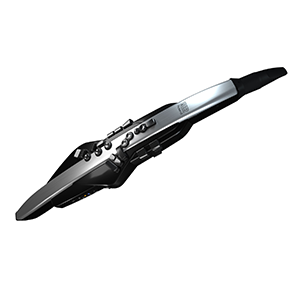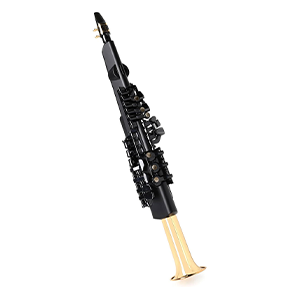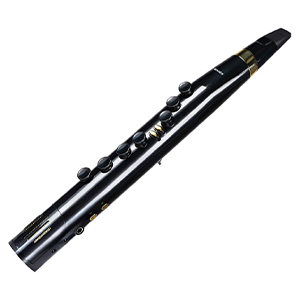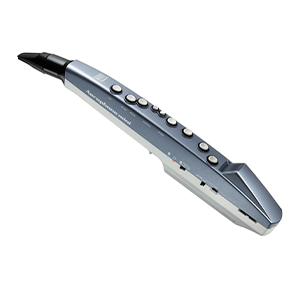As an affiliate, we may earn a commission from qualifying purchases. We get commissions for purchases made through links on this website from Amazon and other third parties.
Before I chose the piano as my main instrument, I harbored a strong admiration for the saxophone. This fondness developed during the 1990s, a period when I regarded saxophonists as the pinnacle of coolness within the jazz community. They effortlessly captivated audiences in concert halls and amassed numerous platinum records.
My familiarity with the saxophone primarily stemmed from pop and smooth jazz musicians like Kenny G, David Sanborn, and Dave Koz. However, my perspective shifted dramatically when I attended a jazz festival in Boston and experienced the remarkable performance of the iconic Michael Brecker. He unexpectedly introduced a synthesizer that resembled a plastic flute and played it with an intensity and skill that evoked the spirit of Eddie Van Halen’s electrifying guitar work. I turned to a fellow saxophonist and asked, “What is that?” He replied, “That’s an EWI.
| Image | Product Name | Editor's Rating | Price |
|---|---|---|---|
 | Roland Aerophone Pro AE-30 | Check Price | |
 | Akai Professional EWI 5000 | Check Price | |
 | Yamaha YDS-150 | Check Price | |
 | MOOER WI100 Mini Electric Saxophone | Check Price | |
 | Roland Aerophone AE-01 | Check Price |
The EWI functions as a specialized synthesizer designed for woodwind players, providing an outstanding platform for creative expression. Let us explore a range of the top choices on the market and uncover the extraordinary soundscapes that can be created with these instruments.
Best Electronic Wind Instruments Reviews
1. Roland Aerophone Pro AE-30
Roland demonstrates exceptional skill in product development, with the Aerophone Pro AE-30 serving as a notable illustration of their proficiency. During my recording session, I was immediately impressed by the outstanding tactile response of the keys. They emulate authentic saxophone action and are meticulously arranged, facilitating a smooth and effortless transition for saxophonists. Moreover, Roland enhances the experience further.
The Aerophone Pro AE-30 not only provides comprehensive USB MIDI control but also features Bluetooth MIDI capabilities, enabling immediate compatibility with software synthesizers. With over 300 internal sounds available, users can begin playing without any delay. The quality of the effects is exemplary, consistent with Roland’s reputation for professional-grade studio effects. One aspect I particularly appreciate is the headphone output, which allows me to practice or warm up prior to a session or performance without causing disruption to others.
Nonetheless, my favorite feature is undoubtedly the breath sensor, which works in conjunction with Roland’s superNATURAL modeling technology. This integration offers an extraordinary level of expressiveness, revealing intricate nuances and subtleties in both sampled and modeled sounds. As a professional engaged in film music, the capability to authentically compose flute and oboe melodies for demos is remarkable.
Additionally, it integrates seamlessly with Kontakt sample libraries, revitalizing my orchestral collections. The only minor issue I have encountered is that, due to the realistic action, the keys may occasionally stick. However, it is important to note that this is a common occurrence even with traditional saxophone keys.
2. Akai Professional EWI 5000
The Akai EWI 5000 marks a notable advancement from its predecessor, the EWI 3000, which gained fame through its association with the iconic Michael Brecker. In contrast to the Roland saxophone layout controller, the EWI 5000 emerges as a genuinely groundbreaking wind instrument. As a proud owner of this device, I can confidently state that it is the most intuitively expressive EWI I have ever experienced.
The arrangement of the keys facilitates smooth portamento octave glides when utilizing synthesizer patches. Moreover, the MIDI timing is remarkably accurate. When interfaced with my Minimoog Model D reissue, I encounter no discernible latency while performing lead sections. The EWI 5000 has been meticulously designed to generate distinctive and engaging sound textures.
The possibilities for sound design are virtually endless. Whether one aims to craft rich pads or dynamic dubstep leads, this instrument provides a creative freedom that traditional keyboards cannot match. In addition to a breath sensor akin to that of the Roland, the EWI 5000 incorporates a unique Bite sensor, allowing users to manipulate sound in a way that mimics the bending of a reed on instruments such as the saxophone or clarinet. I frequently feature this instrument in my live DJ sets, leveraging its wireless audio capabilities and rechargeable battery to create an immersive experience on the dance floor.
The element of surprise enhances the performance, as audiences are often unaware that the Minimoog lead they are hearing is being played live until I fully express my creativity. One minor limitation is the extensive sound library offered by Sonivox. While I do not particularly favor their soft synths and libraries, I have discovered alternatives like Spitfire Audio that better suit my preferences. Nevertheless, the versatility of MIDI opens up a world of endless possibilities for sound creation.
3. Yamaha YDS-150
The Yamaha YDS-150 is a remarkable hybrid instrument that effectively integrates acoustic and digital technologies, marking a notable evolution from conventional Electronic Wind Instruments (EWIs). What distinguishes this hybrid saxophone is its genuine saxophone feel, which has been refined to enhance the overall playing experience. Musicians no longer need to face the challenges of practicing the saxophone, particularly in environments such as apartments or without access to professional equipment.
A particularly noteworthy feature is the presence of a volume control on an acoustic instrument, representing a truly innovative advancement. This capability would have significantly benefited my college years, enabling me to practice without causing disturbances to neighbors. Moreover, the tuning adjustment mechanism is a transformative aspect, especially for soprano saxophone players. Maintaining the instrument’s tuning has historically posed difficulties, but the YDS-150 is meticulously crafted to resolve this concern.
The use of synthetic reeds is another economical advantage, as it reduces the frequency of costly reed replacements. With its battery-operated functionality, USB connectivity, and Bluetooth capabilities, this instrument provides the flexibility to play along with preferred tracks through smartphone integration. For those who continue to utilize traditional acoustic saxophones, the YDS-150 serves as an excellent practice tool. However, the effects section could benefit from enhancements, as the Yamaha Reverb does not possess the rich quality found in Roland’s reverb effects. As a workaround.
4. MOOER WI100 Mini Electric Saxophone
Some preset sounds on various instruments may initially seem unimpressive; however, they can be unexpectedly delightful in their own unique way. I had the chance to explore the Mooer Electric Saxophone, and I was genuinely impressed by its capabilities.
Although the sounds may not possess the utmost authenticity, they evoke memories of the toy keyboards from the 1980s, which I still utilize to craft intentionally eccentric acoustic sound imitations. The Casio Portasound serves as a notable example of this phenomenon. As a sound designer specializing in film music, I am perpetually on the lookout for distinctive sound sources that I can process through an array of effects, including guitar pedals, synthesizers, filters, hardware saturators, reverb, and delays. I chose to experiment with the Mooer due to its impressive original sounds, which can be manipulated to yield fascinating electronic textures.
While I am uncertain if this was the intended application, it proves to be quite effective. With the expressive capabilities of an EWI and a playing style akin to that of an ethnic flute, presets such as male chorus, female chorus, and bamboo flute can result in the production of enchanting sounds. Additionally, I value its compact design and portability. I often take it to my sessions, as it can be seamlessly integrated into intriguing FX chains while still allowing for expressive engagement.
5. Roland Aerophone AE-01
The Roland Aerophone AE-01 is a remarkably noteworthy instrument that may not stand out at first glance when compared to other electronic wind instruments (EWIs) on the market. However, it serves as an excellent resource for novices in wind instruments or for individuals seeking to grasp the basics of playing an EWI.
As a more budget-friendly and lightweight option compared to its professional variant, the AE-30, the AE-01 may lack some of the advanced features found in the AE-30. Nonetheless, its built-in tones and presets deliver outstanding sound quality, enhancing your recordings or musical creations. Furthermore, its portability is a significant benefit, enabling you to transport it effortlessly wherever you may go. While I have not yet acquired this instrument, I have had the chance to play it several times during my DJ performances, and it functioned impeccably.
Connecting it to my system via Bluetooth allowed me to seamlessly engage in improvisation. The AE-01’s integrated speaker is surprisingly effective, making it easy to amplify using a microphone. This instrument evokes memories of the Wurlitzer 200A keyboards, which were initially designed for students with inadequate speakers to facilitate their practice during music lessons. Interestingly, these keyboards have since achieved legendary status as electric pianos, featured in recordings by iconic artists such as Supertramp and the Beatles.
One technique I utilize with the AE-01 involves amplifying the built-in speaker with a microphone. This approach produces an enchanting lo-fi sound that captures a unique essence.
Final Word
There exists a common belief that any electronic representation of an acoustic instrument seeks to replace the original. This was particularly noticeable during the advent of synthesizers, when pianists often criticized the synthetic piano sound for its perceived lack of authenticity. This perspective is similarly applicable to the instrument in question.
When I observed Michael Brecker employing an electric guitar sample, it was clear that he was not trying to replicate the style of a conventional guitarist. His approach transcended mere imitation. His goal was to illustrate his ability to convey emotions through a variety of sounds, especially through innovative and imaginative sampled tones. This is precisely the reason I hold synthesizers and Electronic Wind Instruments (EWIs) in high regard. I view them as extraordinary instruments in our creative toolkit.
